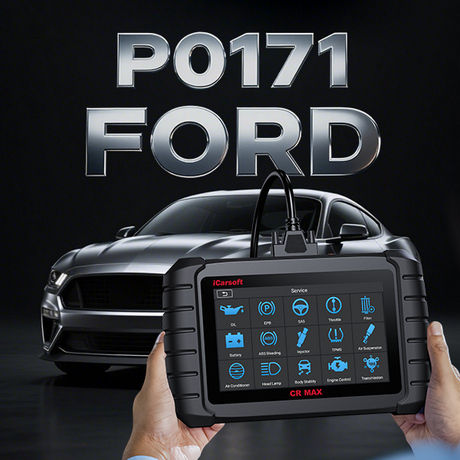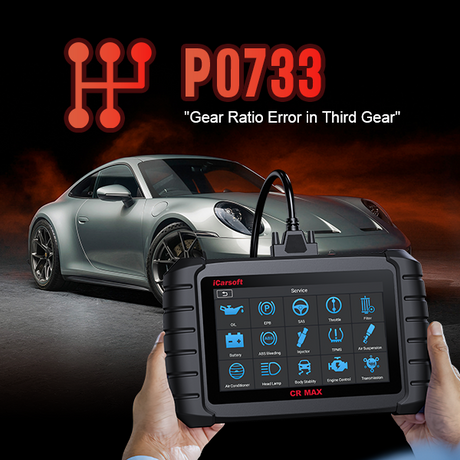Table of Contents
- 1. What Is a Catalytic Converter Issue?
- 2. Causes of Catalytic System Efficiency Problems
- 3. Symptoms of a Catalyst Efficiency Error
- 4. How Serious Is This Emissions Issue?
- 5. Trends in Honda Models Over the Years
- 6. Can You Drive with This Code?
- 7. Best Fixes for Honda Catalyst Issues
- 8. Diagnosing with a Vehicle Diagnostic Tool
- 9. Can CR MAX Diagnose Other Car Brands?
- 10. Cost to Repair Catalyst Efficiency Issues
- 11. Repair Video Tutorial for Honda Owners
- 12. Preventive Measures for Emissions Health
- 13. Frequently Asked Questions
The P0420 code is a common diagnostic trouble code in Honda vehicles, indicating a catalyst efficiency problem. This issue often affects models like the P0420 Honda Accord, P0420 Honda CRV, P0420 Honda Pilot, and P0420 Honda Odyssey. In this guide, we’ll explore the causes, symptoms, and solutions for this emissions failure, with tips on using tools like the iCarsoft CR MAX. For related issues, check out our articles on P0420 in Nissan, P0421, and P0422.
1. What Is a Catalytic Converter Issue?
The P0420 code in Honda vehicles signals that the catalytic converter—a device that reduces harmful emissions like carbon monoxide and nitrogen oxides—is not working efficiently. This issue, often seen in the P0420 Honda Accord or P0420 Honda CRV, means the converter isn’t meeting the manufacturer’s efficiency threshold, leading to higher emissions. The Engine Control Unit (ECU) detects this by comparing data from the upstream and downstream oxygen sensors.
Note: P0420 indicates overall low catalyst efficiency, while P0421 points to warm-up efficiency issues, and P0422 signals a main converter efficiency problem.

2. Causes of Catalytic System Efficiency Problems
Several factors can lead to a catalyst efficiency issue in Honda vehicles:
- Catalytic Converter Failure: Over time, the converter can clog or degrade due to high exhaust gas temperature. For example, a P0420 Honda Pilot may experience this due to prolonged exposure to unburned fuel.
- Faulty Oxygen Sensors: Malfunctioning oxygen sensors can send incorrect data to the ECU. In a P0420 Honda Accord Bank 1, the upstream sensor on Bank 1 might fail, causing inaccurate readings.
- Exhaust Leaks: Leaking in the exhaust before the converter can disrupt oxygen levels. A P0420 Honda Odyssey might face this due to a cracked exhaust manifold.
- Engine Misfires: Misfires send unburned fuel into the converter, overheating it. This is common in a P0420 Honda CRV with worn spark plugs.
- Fuel System Issues: A faulty fuel system (e.g., clogged injectors) can cause an improper air-fuel mixture, damaging the converter, as seen in some P0420 Honda Accord cases.

3. Symptoms of a Catalyst Efficiency Error
A catalytic system efficiency issue can manifest through several symptoms:
- Check Engine Light: The most noticeable sign is a glowing check engine light on the dashboard.
- Reduced Fuel Efficiency: A failing converter can lower fuel systems efficiency, increasing fuel costs.
- Poor Engine Performance: You may experience hesitation, rough idling, or lack of power during acceleration.
- Emissions Failure: The vehicle may fail an emissions test due to increased harmful emissions.
- Unusual Exhaust Smell: A sulfur-like smell (similar to rotten eggs) may indicate a faulty catalytic converter.
In a P0420 Honda Pilot, you might notice rough idling, while a P0420 Honda Odyssey may show a strong exhaust odor.

4. How Serious Is This Emissions Issue?
Driving with this issue won’t immediately damage your Honda, but it’s not advisable long-term. It indicates an emissions failure, which can lead to legal issues in regions with strict regulations. Over time, a faulty catalytic converter can cause engine damage by allowing unburned fuel to overheat components, especially in models like the P0420 Honda CRV.
5. Trends in Honda Models Over the Years
The P0420 code varies across Honda model years:
- Older Models (2003-2007): Vehicles like the 2005 Honda Accord often face converter clogging due to aging catalysts, with repair data showing a 60% failure rate in this range.
- Mid-Range Models (2008-2012): A 2010 P0420 Honda Accord might see issues from improved but still aging exhaust systems.
- Newer Models (2013-2016): Models like the 2015 P0420 Honda Pilot have more sensitive emissions systems, often triggering the code due to minor oxygen sensor issues.
6. Can You Drive with This Code?
You can drive with this code if symptoms are mild (e.g., just a check engine light), but avoid long-term driving. Severe symptoms like power loss or rough idling in a P0420 Honda Odyssey suggest towing to prevent further damage.
7. Best Fixes for Honda Catalyst Issues
Here are the most effective solutions:
- Replace the Catalytic Converter: Use an OEM-equivalent part for models like the P0420 Honda Accord Bank 1.
- Replace Oxygen Sensors: Faulty sensors often cause issues in a P0420 Honda CRV.
- Repair Exhaust Leaks: Fix leaks near the exhaust manifold using repair kits.
- Fix Engine Misfires: Replace spark plugs or ignition coils to prevent unburned fuel damage.
- Clean Fuel System Components: Address fuel systems issues by cleaning injectors in a P0420 Honda Pilot.
8. Diagnosing with a Vehicle Diagnostic Tool
The iCarsoft CR MAX can help diagnose this issue:
- Connect the tool to the OBD-II port under the dashboard.
- Turn on the ignition and the tool, then select your Honda model.
- Read the diagnostic trouble code and freeze-frame data. For example, if the downstream oxygen sensor voltage fluctuates like the upstream sensor (difference <0.1V), the converter may be faulty.
- Inspect the exhaust systems and sensors for damage. If unsure, consult a mechanic.
In a P0420 Honda Accord, high exhaust gas temperature in the data may indicate converter overheating.

Learn More about iCarsoft CR MAX
9. Can CR MAX Diagnose Other Car Brands?
The iCarsoft CR MAX is a multi-brand diagnostic tool, capable of diagnosing issues in Toyota, Nissan, Ford, Chevrolet, and European brands. For example, it can address P0420 in Nissan vehicles with similar accuracy.
Learn More about iCarsoft CR MAX
10. Cost to Repair Catalyst Efficiency Issues
Repair costs vary depending on the issue:
- Oxygen sensor replacement: $100–$300 per sensor
- Exhaust leak repair: $100–$200
- Catalytic converter replacement: $500–$2,500 (plus $200–$500 labor)
Costs may be higher for a P0420 Honda Pilot due to larger exhaust systems.
11. Repair Video Tutorial for Honda Owners
Search YouTube for “Honda P0420 code repair” to find step-by-step videos. These tutorials often show how to diagnose and fix the issue in models like the P0420 Honda Odyssey.
12. Preventive Measures for Emissions Health
To prevent future emissions failure issues:
- Follow Honda’s maintenance schedule, replacing spark plugs every 30,000 miles.
- Use high-quality fuel to avoid contaminants damaging the converter.
- Address engine misfires or rough idling promptly to protect the converter.
- Avoid frequent short trips to ensure the converter reaches optimal temperature.
Tip: Regular maintenance can prevent issues in vehicles like the P0420 Honda Accord or P0420 Honda CRV. Check your fuel system annually to maintain catalytic system efficiency.

13. Frequently Asked Questions
Can I fix this issue myself?
Yes, if you have basic skills. Simple fixes like replacing an oxygen sensor in a P0420 Honda Accord Bank 1 are manageable, but converter replacement may require professional help.
Can cleaning the fuel system help?
Yes, using a fuel system cleaner can improve the air-fuel mixture, potentially resolving minor issues in a P0420 Honda Pilot.
Does the engine affect this code?
Yes, engine misfires or a faulty control module can send unburned fuel into the converter, reducing its efficiency.













